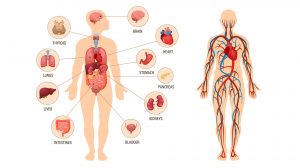Definition
noun, plural: vacuolizations
The formation into, or multiplication of, vacuoles; being filled with vacuoles
Supplement
Vacuolization refers to the state or the process of forming vacuoles. The vacuoles may form inside or adjacent to the cells.1 There are many instances in which vacuoles form. One of which is the neurodegenerative diseases in humans and animals caused by prions. One of the histological features of prion diseases (e.g. Creutzfeldt-Jakob syndrome, Gerstmann-Straussler syndrome, kuru, scrapie, fatal familial insomnia, bovine spongiform encephalopathy, transmissible mink encephalopathy, etc.) is vacuolization in the gray matter. Another is the adult-type rhabdomyoma. It is a benign tumor of striated muscle usually in the head and neck region in the adult-type. The pathologic feature presents a solitary, well-demarcated, submucosal nodule. Histologically, cytoplasmic vacuolization occurs often producing a clear cell appearance or a spider cell formation.2
Word origin: French vacuole, from Latin vacuus (empty) + Latin –ātiōn (state, condition, or process)
Variant(s):
- vacuolisation
Also called:
See also:
- vacuole
- Canavan disease
- Prion diseases
- Armanni-ebstein kidney
- Transcription factor Sp4
- Armanni-ebstein change
Reference(s):
1 Kumar, Vinay; Fausto, Nelso; Abbas, Abul (2004) Robbins & Cotran Pathologic Basis of Disease (7th ed.). Saunders.
2 Hornick, J. (2013). Practical soft tissue pathology a diagnostic approach. Philadelphia, PA: Elsevier/Saunders.







